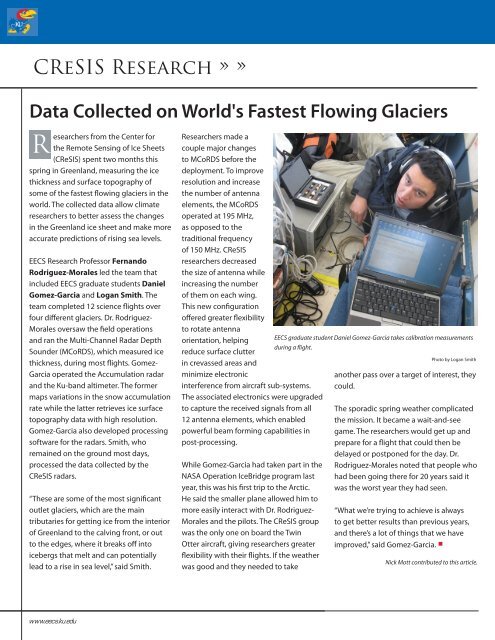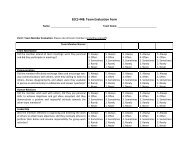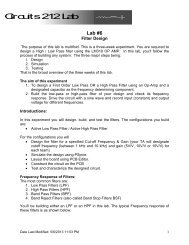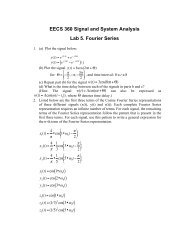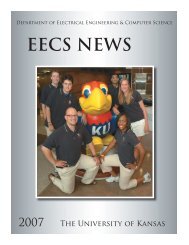2011 Edition - Electrical Engineering and Computer Science - The ...
2011 Edition - Electrical Engineering and Computer Science - The ...
2011 Edition - Electrical Engineering and Computer Science - The ...
- No tags were found...
Create successful ePaper yourself
Turn your PDF publications into a flip-book with our unique Google optimized e-Paper software.
CReSIS Research » »Data Collected on World's Fastest Flowing GlaciersResearchers from the Center forthe Remote Sensing of Ice Sheets(CReSIS) spent two months thisspring in Greenl<strong>and</strong>, measuring the icethickness <strong>and</strong> surface topography ofsome of the fastest flowing glaciers in theworld. <strong>The</strong> collected data allow climateresearchers to better assess the changesin the Greenl<strong>and</strong> ice sheet <strong>and</strong> make moreaccurate predictions of rising sea levels.EECS Research Professor Fern<strong>and</strong>oRodriguez-Morales led the team thatincluded EECS graduate students DanielGomez-Garcia <strong>and</strong> Logan Smith. <strong>The</strong>team completed 12 science flights overfour different glaciers. Dr. Rodriguez-Morales oversaw the field operations<strong>and</strong> ran the Multi-Channel Radar DepthSounder (MCoRDS), which measured icethickness, during most flights. Gomez-Garcia operated the Accumulation radar<strong>and</strong> the Ku-b<strong>and</strong> altimeter. <strong>The</strong> formermaps variations in the snow accumulationrate while the latter retrieves ice surfacetopography data with high resolution.Gomez-Garcia also developed processingsoftware for the radars. Smith, whoremained on the ground most days,processed the data collected by theCReSIS radars.“<strong>The</strong>se are some of the most significantoutlet glaciers, which are the maintributaries for getting ice from the interiorof Greenl<strong>and</strong> to the calving front, or outto the edges, where it breaks off intoicebergs that melt <strong>and</strong> can potentiallylead to a rise in sea level,” said Smith.Researchers made acouple major changesto MCoRDS before thedeployment. To improveresolution <strong>and</strong> increasethe number of antennaelements, the MCoRDSoperated at 195 MHz,as opposed to thetraditional frequencyof 150 MHz. CReSISresearchers decreasedthe size of antenna whileincreasing the numberof them on each wing.This new configurationoffered greater flexibilityto rotate antennaorientation, helpingduring a flight.reduce surface clutterin crevassed areas <strong>and</strong>minimize electronicinterference from aircraft sub-systems.<strong>The</strong> associated electronics were upgradedto capture the received signals from all12 antenna elements, which enabledpowerful beam forming capabilities inpost-processing.While Gomez-Garcia had taken part in theNASA Operation IceBridge program lastyear, this was his first trip to the Arctic.He said the smaller plane allowed him tomore easily interact with Dr. Rodriguez-Morales <strong>and</strong> the pilots. <strong>The</strong> CReSIS groupwas the only one on board the TwinOtter aircraft, giving researchers greaterflexibility with their flights. If the weatherwas good <strong>and</strong> they needed to takeEECS graduate student Daniel Gomez-Garcia takes calibration measurementsPhoto by Logan Smithanother pass over a target of interest, theycould.<strong>The</strong> sporadic spring weather complicatedthe mission. It became a wait-<strong>and</strong>-seegame. <strong>The</strong> researchers would get up <strong>and</strong>prepare for a flight that could then bedelayed or postponed for the day. Dr.Rodriguez-Morales noted that people whohad been going there for 20 years said itwas the worst year they had seen.“What we’re trying to achieve is alwaysto get better results than previous years,<strong>and</strong> there’s a lot of things that we haveimproved,” said Gomez-Garcia. •Nick Mott contributed to this article.www.eecs.ku.edu


